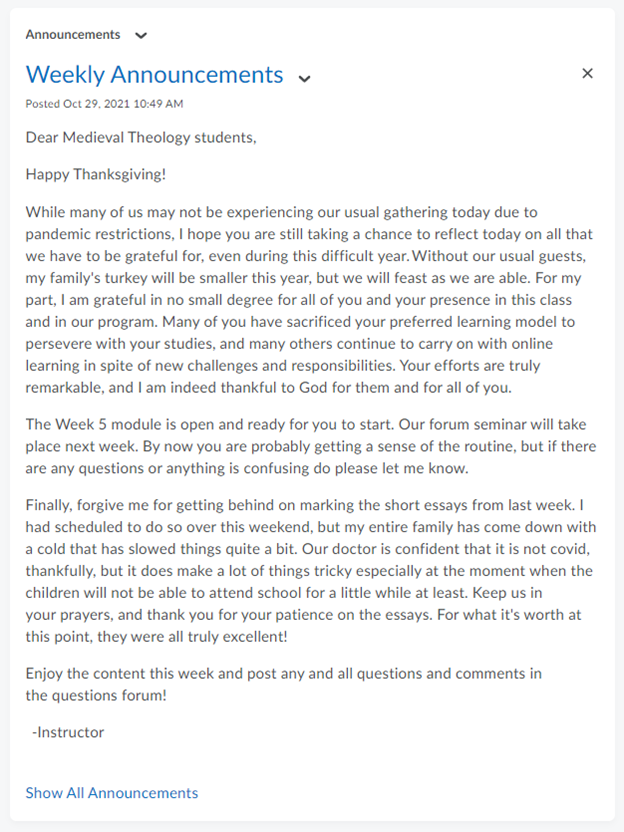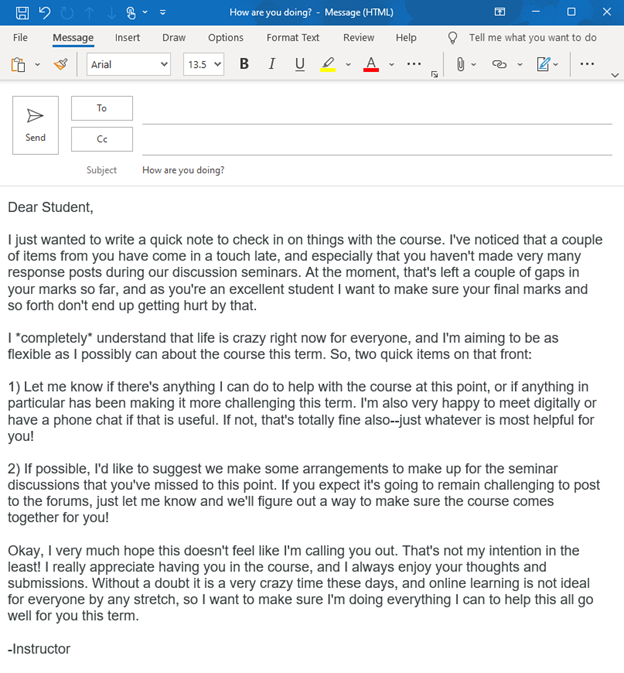Module 4: Quality facilitation and improvement
4.4 Building teaching presence during term
What is teaching presence?
As noted in the previous section, teaching presence is something experienced by learners when they perceive the impact of your expertise and personal investment in their learning. Teaching presence can be created at any distance, through a wide variety of media, and is something we build into courses when designing them and cultivate actively when teaching them.
We define teaching presence as the design, facilitation, and direction of cognitive and social processes for the purpose of realizing personally meaningful and educationally worthwhile learning outcomes. Teaching presence begins before the course commences as the teacher, acting
as instructional designer, plans and prepares the course of studies, and it continues during the course, as the instructor facilitates the discourse and provides direct instruction when required.(Anderson et al., 2001)
Why teaching presence matters
It is, of course, possible in our age to learn nearly anything you wish on your own time using nothing more than an internet connection and possibly a library. Yet, when we are serious about learning something, most of us are likely to enroll in a course of instruction of some kind to meet our learning goals.

In other words, humans tend to seek guidance of some kind when gaining new knowledge and learning new skills. The raw availability of information is not sufficient—we need experts to help us to know what information to focus on and help us put various elements together into greater structures of knowledge and skill. In short, teaching presence matters simply because humans learn best from other humans and not from static documents, videos, and the rest.
Strategies for building teaching presence

Welcome announcements
First impressions matter, so start off on the right foot by welcoming learners into your course the way you might welcome someone into your classroom or home. You can welcome learners with a typed message or a personalized video distributed through the Announcements function present in most Learning Management Systems (LMSs). Some suggested talking points for a useful welcome announcement are listed below.
- Introduce yourself. Briefly tell learners a bit about yourself and what you are excited about in the course (content or assessments). Try to keep it short, but consider including a hook of some kind to pique their interest. You can direct them to a page in the course syllabus or an About the Instructor or About the TA page. The more information you provide about yourself, the more likely they are to relate to you. If you have them, encourage your TAs to introduce themselves as well via video or discussion board.
- Show them around. Help learners quickly orient to the organization and layout of the course. Courses may be organized in different ways that are not always intuitive. Provide learners with a quick overview of where they can find critical information in the course (especially the course schedule). If there is a task, activity, or assessment that they must complete in the first week or two (e.g., join groups, introduce themselves in a discussion forum, complete a prelearning quiz, etc.), point that out for them in your welcome message. Remember, many online courses are self-paced, and without explicit direction, some learners may not really dig into course content until week two or three.
- Help them feel at ease. Highlight for your learners how they can get help and support from you. What are you committing to in terms of communication and monitoring? What should they expect in terms of email response wait times? It’s helpful to set these expectations early. If you have included details about this elsewhere in your course (e.g., the syllabus or a contact information page), point out that this information can be found there.
This first announcement can really set the tone for the course. And remember your announcement can simply be made on a smartphone or a normal desktop computer. You don’t need to be fancy—in fact, simpler videos can provide a helpful human touch for your learners.
Examples of welcome announcements
Quality Essential
Example 1: Welcome announcement
A simple welcome announcement for a course on online teaching from Michelle Pacansky-Brock.
Transcript for Welcome to Humanizing Online Teaching and Learning available on YouTube. | Video length ~ 2 mins.
(Pacansky-Brock, 2018)
Weekly announcements
Weekly announcements are one of your best platforms for creating teaching presence in your course. Creating at least one fresh announcement each week signals your ongoing engagement and lets learners know you remain invested in the course and their success.
Regular announcements can also be used to create opportunities for direct instruction, for instance by clarifying a point of confusion that has arisen for learners, sharing supplementary materials, or connecting a current topic to events in the news, among other strategies.
Even if there isn’t much to say in a given course week, make an announcement anyway. And whatever you share in your announcements, use them as an opportunity to celebrate your learners’ success, show empathy with their struggles, and above all signal that you are available if and when they need help on anything big or small.
Quality Essential
Example 2: Text-based weekly announcement
Here is a real example of a weekly announcement from an instructor during term.

Credit: Daniel Opperwall, Trinity College, University of Toronto | Image Description
Quality Advanced
Example 3: Video weekly announcement
Instead of a text-based weekly announcement, you can try a video announcement like this one from Denise Maduli-Williams.
Transcript for Week2Fall2019 available on YouTube. | Video length ~ 1 min.
(Maduli-Williams, 2019)
Sharing your personality
What instructors have to say…
“Being personable does not mean you need to get personal.”
Credit: Prof. James Skidmore, online instructor
What learners have to say…
“I like the personalization myself … takes away a lot of those ‘barriers’ we get in online courses with our instructors. Puts a person to the name. And those personalities! So much passion for what they do … it’s clear, and motivating. You don’t want to disappoint them.”
Credit: Julie, online learner
We all have different personalities and teaching styles. Authenticity is important not only for ensuring that you don’t spend excessive time editing and sculpting your persona, but also because when interactions online are not authentic, learners see that and appreciate them less. While authenticity is key, we can and should take advantage of one of the benefits of asynchronous interactions with learners, which is that it provides a natural temporal lag that enables us to be more mindful of what we present to learners and how we respond to their inquiries.
Here are two tips for putting your best online facilitator self forward, adapted from Errol Craig Sull (2012):
- Establish a friendly and inviting persona on day one of class. You have only one chance to make a first impression, and in the online classroom, this is especially true. Your message on day one can be examined, experienced, and revisited throughout the course. Thus, postings should convey that you care about the class, the learners, and the subject, and that you are looking forward to the course and are eager to help your learners.
- Use your interest in the subject to help build your online teaching personality. You were selected to teach your subject because of your academic and/or professional expertise and interest in the subject, so share it with your learners. Beyond what has been prestocked in your course, you can often add articles, pictures, essays, cartoons, interviews, YouTube (and the like) snippets, and factoids that add richness and depth to your subject. The learners will immediately know you really are “into” the subject, and your excitement and enthusiasm will spill over.
Remember, you don’t need to share private details about your life in order to establish your personality. Keep things light but authentic whenever you can. Consider creating an “About the instructor” or “About the author” page for your course, like the below example from one of the members of our team, where you can share a little bit about yourself. In addition, see some of the example announcements above, which also show instructor presence and personality in a variety of ways.
Quality Essential
Example 4: Instructor bio page
Kristin Wilson — Course Author

Background
I completed my PhD in Cognitive Neuroscience at the University of Toronto, where I taught large undergraduate courses, was involved in training and mentoring TAs, and conducted research on individual differences in attention and memory. I completed a postdoctoral fellowship at the University of Waterloo, studying cognition in online learning environments before I joined the Centre for Extended Learning (CEL) as an Online Learning Consultant (OLC).
Current role and interests
I love the creative and collaborative nature of my role as an OLC at CEL, working closely with faculty and graduate students across academic disciplines, finding novel and creative ways to bring their online courses to life for their students. I enjoy drawing on research and what we know about human cognition and learning to optimize online courses and helping online facilitators find their authentic teaching persona online.
Personal
I live in Guelph with my husband, 16-year-old step-daughter, and golden doodle, Kenobi. When not at work, I spend most of my time outdoors (hiking, kayaking, gardening, biking, etc.). I also love practising and sharing mindful movement through yoga. I have been practising yoga for about 20 years and teaching yoga for the past eight years and love that I still feel like a beginner and there is so much to learn and explore.
Individual communications and timely responses
Individual communications are another crucial space for signalling your teaching presence to learners. Among the most important things to keep in mind about personal communications is that they should be as timely as possible. Some good rules of thumb are stated below.

- Respond to all individual communications within 24 hours when possible. Doing so signals your commitment to the course and your learners’ success. However, if 24 hours is not reasonable in general or in a particular situation, or if you have certain windows where you will not be responding (evenings, weekends, etc.), simply let your learners know when they should expect a response from you and stick with the time frame. Your wellness matters too, and as long as learners know when they should expect to hear back, they are typically flexible about response times.
- For feedback and marking assessments, set learner expectations and follow through. Make sure your timeline is clear to your learners and stick to it. Make sure your timeline is reasonable for your TAs, you (your energy and morale are important too!), and for your learners if they are expected to use your feedback for another assessment (e.g., feedback on a draft paper to guide their final draft).
Reaching out to learners
All modern LMS providers allow at least some degree of learner-progress tracking. Keeping an eye on how often your learners are checking into the course, and how much progress they are making, is an essential strategy for creating connection with your learners, especially with those who may be falling behind.
Check in on learner progress regularly during term. When you see learners falling behind, or perhaps never even starting the course, reach out with an email or other communication to check in with how they are doing and how you can help. Keep in mind that the purpose is not to call out learners for not keeping up, but to offer support to get them through the course. There are countless reasons that learners may fall behind, such as everyday busyness, major life events like a death in the family, difficulty understanding materials, minor or serious mental health concerns, and more. Figuring out what is going on with a given learner is the first step toward helping them catch up.
When sending a message to a learner who has fallen behind, aim to offer them as much flexibility as you can without sacrificing your learning outcomes, and be sure to signal your compassion for their situation whatever it might be. Often simply knowing that someone cares is enough to get a learner back on track. In other cases, accommodations may be needed in order to assist a learner in catching up. Still, other learners may need substantially more support such as through your campus mental health supports or accessibility services. You do not need to take on the burdens of the learner’s situation, but you should be able to readily suggest these institutional resources when learners disclose challenges in keeping up (e.g., by providing direct links to websites or emails). It is important to normalize the seeking of help on the part of students and to allow them to decide if they need additional assistance. While you cannot sacrifice the fundamental learning requirements of your course for a struggling learner, knowing that they have an ally in meeting those requirements has a huge positive impact on reducing course attrition and helping all learners to succeed.
Quality Essential
Example 5: Outreach email
Here is a real example of an outreach email from an instructor during term, with personal details redacted to protect privacy.

Credit: Daniel Opperwall, Trinity College, University of Toronto | Image Description
An EDII perspective: Signalling your commitment to diverse perspectives
If you are having difficulty in incorporating diverse perspectives into your formal course content, course announcements are a great place to build a social presence that privileges different voices, perspectives, worldviews, or social issues that may still be emergent in the scholarly literature or have not yet been formally incorporated into the curriculum. Using popular media or grey literature can also help connect a discipline to the “real world” and/or help learners gain a different perspective, which may ultimately help them with their learning in the course or when working on assignments. Below, here are some ideas to stimulate your thinking.
- For a human resources course, post a news story discussing how a specific industry is exploring alternate training avenues for new career professionals or how hiring practices are being otherwise disrupted.
- In a communications course, post a recent new photograph, political cartoon, or meme and dissect the messaging, stereotypes, and biases that are demonstrated, using your expertise.
- In a public health course, highlight a news story or video of a successful intervention conducted with a marginalized group.
- Post a video of a first-person perspective account (someone speaking in their own words) or reflection of how a course topic impacts them or their community.
- In a STEM course, evaluate how a concept is communicated in popular media and demonstrate how it is important for those in STEM to be able to articulate their work to different audiences (scholarly vs. lay) to ensure nothing is “lost in translation.”
- In a political science course, post a news item and briefly explore what is or isn’t said.
Activity: Create a welcome announcement
Learning outcomes
This activity is directly aligned with Course Learning Outcome (CLO) 7: Employ effective facilitation strategies when delivering your online course.
Instructions
For this activity, craft a welcome announcement for use in one of your courses.
Option 1: Download the Welcome Announcement Worksheet.docx to complete offline.
Option 2: Complete the activity in-line below. If you wish to save your in-line results, be sure to download your work by clicking the Export tab at the bottom of the left-hand navigation bar in the activity before moving on.
Please note, this activity is intended for your own reflection and learning. Your responses are private and are deleted when you refresh or navigate away from this page.

